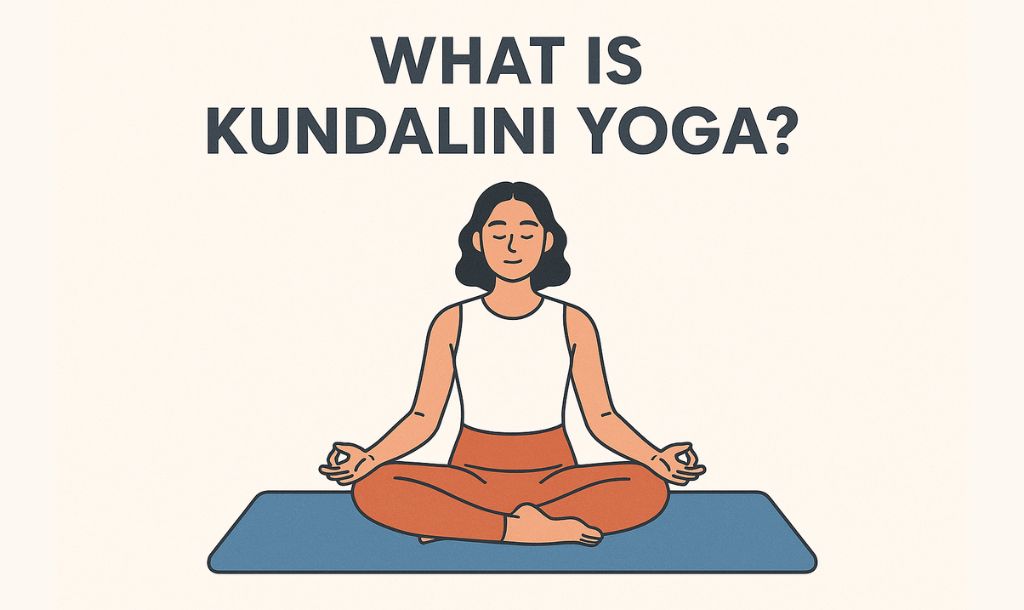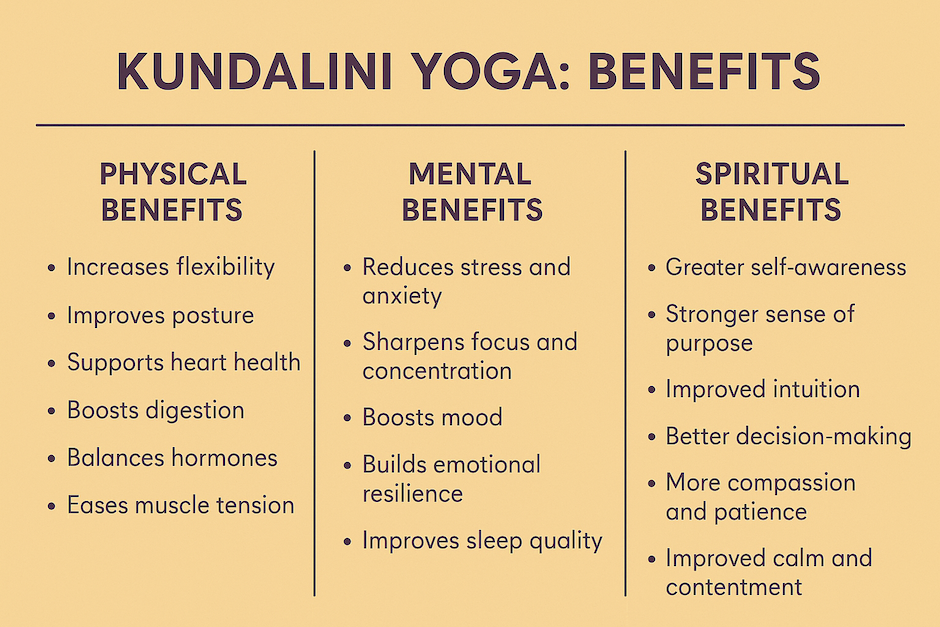

Kundalini Yoga is a dynamic practice that combines movement, breathing techniques, meditation, and chanting to awaken kundalini—a dormant energy said to rest at the base of the spine. Introduced to the West by Yogi Bhajan in 1969, it helps improve focus, calm the mind, and boost vitality through specific, time-tested sequences.
The word kundalini comes from the Sanskrit “kundal,” meaning “coiled,” symbolizing the potential energy lying at the base of the spine. In early yogic and Tantric traditions, awakening this energy was seen as a path to greater awareness and inner growth.
Unlike more physically oriented yoga styles, the blend of movement, breathwork, mantras, and meditation in Kundalini creates both mental clarity and physical strength. While its philosophy dates back thousands of years, Yogi Bhajan adapted the practice to fit modern life—helping people manage stress, boost focus, and feel more balanced throughout the day.
Explore different types of yoga here!
It’s natural to wonder, “Why do some people say Kundalini yoga is dangerous?” After all, the practice has a reputation for being intense because it works with both the body and the mind. In reality, Kundalini yoga is safe when learned gradually and taught by an expert yoga instructor. The challenges arise mainly when people try advanced techniques too quickly or without proper guidance.
Kundalini yoga is sometimes called “dangerous” because it can trigger strong physical or emotional reactions if practiced incorrectly. The breathing exercises and meditations are designed to move energy through the body, which can feel intense—especially for beginners.
In the past, these teachings were kept private and passed directly from teacher to student to ensure proper guidance. Today, when people try advanced techniques on their own—without preparation or instruction—they may experience heat along the spine, dizziness, anxiety, or emotional surges.
So, while the practice itself isn’t dangerous, rushing the process or skipping guidance is.
When practiced correctly, Kundalini yoga is completely safe. The modern form, as taught by Yogi Bhajan, was designed specifically for people living active, busy lives.
Safety in Kundalini yoga comes down to three key factors:
With proper guidance, you learn that sensations such as warmth, lightness, or emotional release are simply signs that your body and mind are releasing tension and restoring balance.

[inline-CTA-1]
Unlike faster-flowing yoga styles such as Vinyasa, Kundalini yoga follows a steady rhythm that combines movement, breath, sound, and rest. Each class includes specific sequences that strengthen the body, steady the breath, and improve focus.
A typical session includes five main components:
Every Kundalini class begins with the Adi Mantra — “Ong Namo Guru Dev Namo” — which means “I bow to the divine teacher within.”
This short chant helps students shift from daily distractions into a mindful, receptive state. It creates a sense of calm, focus, and respect for the practice ahead.
Breath is central to Kundalini yoga. Through pranayama (controlled breathing), students learn to direct and expand energy within the body.
Common techniques include:
These breathing techniques improve circulation, strengthen the lungs, and boost overall energy.
In Kundalini yoga, a kriya is a complete practice made up of a specific set of exercises, breathing techniques, and short meditations. Each kriya has a clear purpose — for example, to relax the nervous system, strengthen the spine, or lift your mood.
During a kriya, you will be guided through poses and breathing patterns in a set order. While some movements are repeated for several minutes, others may be held steady as you focus on breathing or a simple mantra.
This structure makes each class feel purposeful and balanced. You move, breathe, rest, and reflect, all within the same sequence.
Example: In a kriya for emotional balance, you might gently flex the spine while breathing deeply, then pause to chant a calming sound before resting in stillness.
After physical movement, the practice often transitions into meditation and mantra chanting — such as the well-known “Sat Nam” (meaning “I am truth”).
Chanting uses sound vibration to focus the mind, while hand positions (mudras) guide energy flow. This combination helps beginners and advanced practitioners experience deep peace and clarity.

Each class ends with Savasana (deep relaxation) and sometimes a closing song or blessing.
This resting phase allows the body and nervous system to integrate the energy generated during the kriya, leaving the practitioners feeling refreshed and centered.

[inline-CTA-2]
Kundalini yoga is more than just stretching or deep breathing — it’s a whole-body and mind reset. Even a few sessions can bring noticeable shifts in mood, energy, and mental clarity.
Some key benefits include:
Kundalini yoga supports the body from the inside out. Regular practice can:
The mix of movement, focused breathing, and short meditations helps quiet the mind and improve emotional balance. Regular practice can:
Kundalini yoga is often called “the yoga of awareness” because it strengthens the connection between mind and inner self. Practitioners often experience:
When practiced regularly — even for just 15–20 minutes a day — the benefits of Kundalini yoga extend far beyond the mat.
If you’ve practiced Hatha, Vinyasa, or Yin yoga before, you might notice that Kundalini yoga feels very different. While many yoga styles focus mainly on physical postures, Kundalini integrates the energetic, mental, and spiritual aspects of yoga into every session.
Here’s a simple comparison:
In short, Kundalini yoga is less about how your body looks in a pose and more about how your energy feels within it. It’s a meditative experience that blends breath, sound, and movement to help you reconnect with your authentic self.
Kundalini is ideal for:
Under the right guidance, Kundalini Yoga gently builds strength, focus, and emotional balance from the inside out.
You don’t need to be flexible or spiritually inclined to begin Kundalini yoga — just curiosity and the right guidance. Because the practice uses breathwork, movement, and meditation together, learning from an experienced teacher is the key to staying safe and confident.
While Kundalini yoga is safe for most people, it’s wise to consult your healthcare provider before starting if you have:
Always listen to your body. If you feel dizzy or emotionally overwhelmed, pause, rest, and talk to your teacher.
Absolutely! When taught by a qualified instructor, Kundalini yoga is suitable for beginners. Start with basic breathing techniques and simple kriyas to build a safe, steady foundation before advancing.
For a well-rounded and safe Kundalini practice, book a free 1-on-1 session today!
Consistency is more important than duration. Practicing two to three times per week is a great start. As your body adapts, you can increase to daily sessions. Even 10–15 minutes of focused breathwork or meditation can bring lasting calm and clarity.
Not at all. Most Kundalini poses are gentle, seated, or repetitive — flexibility develops naturally over time. The real focus is on breath and awareness, not perfect posture.
Wear comfortable, breathable clothing that allows free movement. Many practitioners choose white or light colors to enhance focus, but it’s entirely optional. Natural fabrics like cotton are best.
No! Kundalini yoga is spiritual, not religious. It’s based on universal principles of awareness, breath, and energy that complement any belief system—or none at all. You can practice it purely for health, focus, or personal growth.
You may notice certain mental and emotional benefits after your first few sessions—such as relaxation, clarity, and energy balance. Physical improvements and deeper self-awareness typically develop within a few weeks of consistent practice.

Receive personalized guidance tailored to your unique fitness goals, live with a dedicated coach—no credit card required.